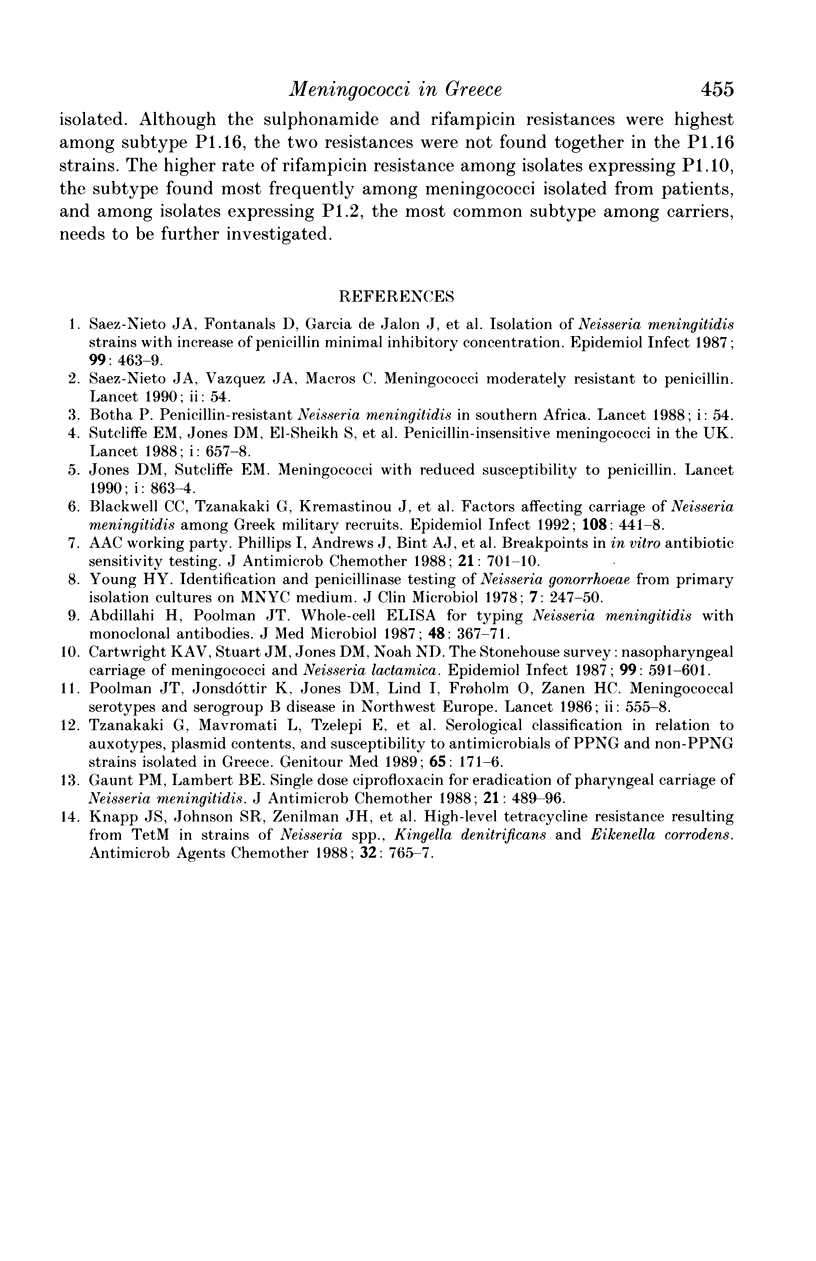Abstract
Usage of antibiotics in southern Europe is less well regulated than in northern countries. The proportion (48%) of meningococci in Spain insensitive to pencillin (MIC greater than or equal to 0.1 mg/l) prompted this investigation of antibiotic sensitivities of isolates from Greek patients with meningitis (31) and carriers (47 school-children and 472 recruits). The agar dilution method was used to determine MIC to penicillin G (PN), sulphamethoxazole (SU), rifampicin (RF), cefaclor (CF) and ciprofloxacin (CP). The proportion of isolates insensitive to PN was 48% for isolates from patients, 19% from school-children and 36.6% from recruits. Resistance to SU (MIC greater than or equal to 16 mg/l) was found in 16% of those from patients, 10.6% from children and 40% from recruits. None of the isolates from patients was resistant to RF (greater than or equal to 1 mg/l) but 6% of those from carriers were. Resistance to CF (greater than or equal to 4 mg/l) was found in 9.2% of patient isolates, 6.4% from children and 23.7% from recruits. All isolates except one were sensitive to CP (MIC range less than 0.0015-0.125 mg/l). Resistances to PN, SU and RF were analysed by serogroup, serotype and subtype of the bacteria. The proportion of resistant isolates showed some variation between different areas of Greece, but it was not statistically significant.
Full text
PDF






Selected References
These references are in PubMed. This may not be the complete list of references from this article.
- Blackwell C. C., Tzanakaki G., Kremastinou J., Weir D. M., Vakalis N., Elton R. A., Mentis A., Fatouros N. Factors affecting carriage of Neisseria meningitidis among Greek military recruits. Epidemiol Infect. 1992 Jun;108(3):441–448. doi: 10.1017/s0950268800049943. [DOI] [PMC free article] [PubMed] [Google Scholar]
- Botha P. Penicillin-resistant Neisseria meningitidis in southern Africa. Lancet. 1988 Jan 2;1(8575-6):54–54. doi: 10.1016/s0140-6736(88)91029-x. [DOI] [PubMed] [Google Scholar]
- Cartwright K. A., Stuart J. M., Jones D. M., Noah N. D. The Stonehouse survey: nasopharyngeal carriage of meningococci and Neisseria lactamica. Epidemiol Infect. 1987 Dec;99(3):591–601. doi: 10.1017/s0950268800066449. [DOI] [PMC free article] [PubMed] [Google Scholar]
- Gaunt P. N., Lambert B. E. Single dose ciprofloxacin for the eradication of pharyngeal carriage of Neisseria meningitidis. J Antimicrob Chemother. 1988 Apr;21(4):489–496. doi: 10.1093/jac/21.4.489. [DOI] [PubMed] [Google Scholar]
- Jones D. M., Sutcliffe E. M. Meningococci with reduced susceptibility to penicillin. Lancet. 1990 Apr 7;335(8693):863–864. doi: 10.1016/0140-6736(90)90985-e. [DOI] [PubMed] [Google Scholar]
- Knapp J. S., Johnson S. R., Zenilman J. M., Roberts M. C., Morse S. A. High-level tetracycline resistance resulting from TetM in strains of Neisseria spp., Kingella denitrificans, and Eikenella corrodens. Antimicrob Agents Chemother. 1988 May;32(5):765–767. doi: 10.1128/aac.32.5.765. [DOI] [PMC free article] [PubMed] [Google Scholar]
- Poolman J. T., Lind I., Jónsdóttir K., Frøholm L. O., Jones D. M., Zanen H. C. Meningococcal serotypes and serogroup B disease in north-west Europe. Lancet. 1986 Sep 6;2(8506):555–558. doi: 10.1016/s0140-6736(86)90123-6. [DOI] [PubMed] [Google Scholar]
- Saez Nieto J. A., Vazquez J. A., Marcos C. Meningococci moderately resistant to penicillin. Lancet. 1990 Jul 7;336(8706):54–54. doi: 10.1016/0140-6736(90)91567-t. [DOI] [PubMed] [Google Scholar]
- Sutcliffe E. M., Jones D. M., el-Sheikh S., Percival A. Penicillin-insensitive meningococci in the UK. Lancet. 1988 Mar 19;1(8586):657–658. doi: 10.1016/s0140-6736(88)91469-9. [DOI] [PubMed] [Google Scholar]
- Sáez-Nieto J. A., Fontanals D., Garcia de Jalon J., Martinez de Artola V., Peña P., Morera M. A., Verdaguer R., Sanfeliu I., Belio-Blasco C., Perez-Saenz J. L. Isolation of Neisseria meningitidis strains with increase of penicillin minimal inhibitory concentrations. Epidemiol Infect. 1987 Oct;99(2):463–469. doi: 10.1017/s0950268800067960. [DOI] [PMC free article] [PubMed] [Google Scholar]
- Tzanakaki G., Mavrommati L., Tzelepi E., Kolyva S., Fragouli E. Serological classification in relation to auxotypes, plasmid contents, and susceptibilities to antimicrobials of PPNG and non-PPNG strains isolated in Greece. Genitourin Med. 1989 Jun;65(3):171–176. doi: 10.1136/sti.65.3.171. [DOI] [PMC free article] [PubMed] [Google Scholar]
- Young H. Identification and penicillinase testing of Neisseria gonorrhoeae from primary isolation cultures on modified New York City medium. J Clin Microbiol. 1978 Mar;7(3):247–250. doi: 10.1128/jcm.7.3.247-250.1978. [DOI] [PMC free article] [PubMed] [Google Scholar]


